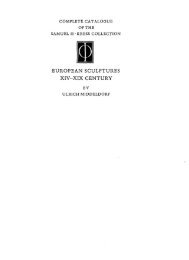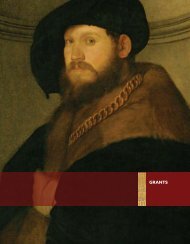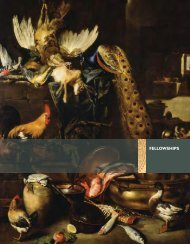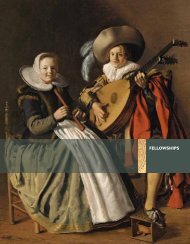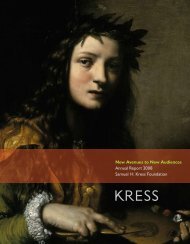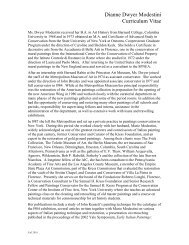The Campus Art Museum - Samuel H. Kress Foundation
The Campus Art Museum - Samuel H. Kress Foundation
The Campus Art Museum - Samuel H. Kress Foundation
Create successful ePaper yourself
Turn your PDF publications into a flip-book with our unique Google optimized e-Paper software.
Table 11.1. Examples of How Professors in the <strong>Art</strong>s and <strong>Museum</strong> Studies<br />
Use <strong>Campus</strong> <strong>Art</strong> <strong>Museum</strong>s to Help Students Develop Specific Skills<br />
Crafting <strong>Museum</strong> Labels<br />
“Probably the most comprehensive use of the museum was a course I did this past summer called ‘Greek Vases in the<br />
[campus art museum]’…. We’d have one day of lecture and one day in the museum and then one day of lecture and<br />
one day in the museum and this went on for the six weeks…. We would cover a particular area and then we’d go in<br />
and apply that knowledge in some fashion to the museum collection. Each student had what I call their special days<br />
and each student was responsible for working on their special days throughout the duration of the course. <strong>The</strong>re<br />
were four short essays about some aspect of their vase, what it looked like, how it was produced, pictures on it, the<br />
iconography of it. <strong>The</strong>y’d have to do some research and the final product was to write a new museum label. So the<br />
idea was for them to take all that material and to synthesize it into something that had them make some choices about<br />
what they thought were the most important features of their vessel.” (art history professor)<br />
Selecting New Aquisitions<br />
“One of my favorite assignments is to ask students to go to the collection and look around. <strong>The</strong>n I pull out a whole<br />
bunch of Sotheby’s and Christie’s catalogues from recent sales and I ask them to select a piece—[to pretend] that an<br />
anonymous donor has agreed to purchase anything in the world for the [campus art museum]—to select from these<br />
catalogues which they would purchase and why. So the idea is that they have to look at the collection and think about<br />
its scope and add something to the collection that would either fill a hole or expand upon an existing strength. <strong>The</strong>y<br />
have to write about why they would select that, where they would display it, and, in a sense, justify that donation. It’s<br />
a way of getting them to think about the collection as a curator would in a synthetic way. It’s one of my favorite paper<br />
assignments and the students tend to do very well with it.” (art history professor)<br />
Practicing <strong>Art</strong>istic Techniques<br />
“We look at master drawings in digital form, projected, all semester long, and at models. I usually leave the [campus<br />
art museum to last]…. <strong>The</strong>re they get to copy from master drawings, right there in front of them. <strong>The</strong>y could reach<br />
out and touch them. <strong>The</strong> students absolutely love that assignment and as part of the requirements for the class, I have<br />
them turn in a portfolio and ask them to frame one drawing…. I would say about half the class chooses to frame their<br />
copy of the master drawing and I know they keep that forever.” (studio arts professor)<br />
Professors in the arts find that they make impromptu use of the campus museum<br />
in their classes as well, as a studio art professor describes:<br />
In my painting classes, I’m always sure to bring my students through here<br />
whenever somebody in class might be struggling with some kind of technical<br />
aspect. You know, like “I don’t know how to do hair.” And I say, “OK, let’s come<br />
over to the [campus art museum].” <strong>The</strong>re are lots of examples and people really<br />
learn by actually looking at the paintings. You can see it in a way that you just<br />
cannot in reproductions…all of the surface qualities…. It’s really pretty terrific<br />
having this museum here and being able to just run over, look at something,<br />
and then go back.<br />
<strong>Art</strong> education professors incorporate the campus art museum into general<br />
education classes with a focus on practicing pedagogical skills in a new context.<br />
<strong>The</strong>y may, for example, group students with docents to learn about working with<br />
children in the museum. An art education professor describes how this gets some<br />
students into the art museum for the first time:<br />
You’ll have these young adults in the class and many of them have never visited<br />
a museum, let alone the museum that’s on their own campus. So, we often<br />
make a point of taking those groups over to the museum…. Here they have<br />
what they call the Second Grade Tour…. Our students walk through the museum<br />
with a docent… [who takes] them through the same tour that the second<br />
graders would experience. <strong>The</strong> docents talk about how they engage them, they<br />
Meeting Course Objectives through the <strong>Art</strong> <strong>Museum</strong><br />
12



